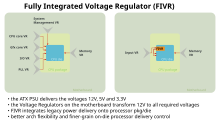
Back Broadwell (microarquitectura) Catalan Broadwell Czech Intel-Broadwell-Mikroarchitektur German Broadwell (microarquitectura) Spanish Broadwell Estonian Intel Broadwell Finnish Broadwell (hardware) Italian Broadwellマイクロアーキテクチャ Japanese 브로드웰 (마이크로아키텍처) Korean Broadwell (Intel) Dutch
| General information | |
|---|---|
| Launched | October 27, 2014 |
| Discontinued | November 2018[1] |
| Marketed by | Intel |
| Designed by | Intel |
| Common manufacturer(s) |
|
| CPUID code | 0306D4h |
| Product code |
|
| Performance | |
| QPI speeds | 6.4 GT/s to 9.6 GT/s |
| DMI speeds | 4 GT/s |
| Cache | |
| L1 cache | 64 KB per core |
| L2 cache | 256 KB per core |
| L3 cache | 2-6 MB (shared) |
| L4 cache | 128 MB of eDRAM (Iris Pro models only) |
| Architecture and classification | |
| Technology node | 14 nm (Tri-Gate) |
| Microarchitecture | Haswell |
| Instruction set | x86-16, IA-32, x86-64 |
| Extensions | |
| Physical specifications | |
| Cores |
|
| GPU(s) |
|
| Socket(s) | |
| Products, models, variants | |
| Product code name(s) |
|
| Brand name(s) | |
| History | |
| Predecessor(s) |
|
| Successor(s) | Skylake (Tock/Architecture) |
| Support status | |
| Unsupported | |

Broadwell (previously Rockwell) is the fifth generation of the Intel Core processor. It is Intel's codename for the 14 nanometer die shrink of its Haswell microarchitecture. It is a "tick" in Intel's tick–tock principle as the next step in semiconductor fabrication.[2][3][4] Like some of the previous tick-tock iterations, Broadwell did not completely replace the full range of CPUs from the previous microarchitecture (Haswell), as there were no low-end desktop CPUs based on Broadwell.[5]
Some of the processors based on the Broadwell microarchitecture are marketed as "5th-generation Core" i3, i5 and i7 processors. This moniker is however not used for marketing of the Broadwell-based Celeron, Pentium or Xeon chips. This microarchitecture also introduced the Core M processor branding.
Broadwell is the last Intel platform on which Windows 7 is supported by either Intel or Microsoft; however, third-party hardware vendors have offered limited Windows 7 support on more recent platforms.[6]
Broadwell's H and C variants are used in conjunction with Intel 9 Series chipsets (Z97, H97 and HM97),[7] in addition to retaining backward compatibility with some of the Intel 8 Series chipsets.[citation needed]
- ^ Perillo, Ron (November 9, 2017). "Intel Broadwell-E CPUs Officially Discontinued". eTeknix. Retrieved July 29, 2020.
- ^ "22nm Details" (PDF) (presentation). Intel. Retrieved January 4, 2012.
- ^ Demerjian, Charlie (March 31, 2011). "After Intel's Haswell comes Broadwell". SemiAccurate. Retrieved January 4, 2012.
- ^ Broekhuijsen, Niels (May 22, 2014). "Intel Broadwell CPUs to Arrive Later This Year". Tom's Hardware. Archived from the original on July 27, 2014. Retrieved May 31, 2014.
- ^ "Lower-end desktop CPUs won't get Broadwell, will need to wait for Skylake". Ars Technica. September 5, 2014.
- ^ "Biostar Adds Windows 7 Support to Dozens of Current Gen Motherboards". Tom's Hardware. April 10, 2019.
- ^ Reynolds, Sam (August 26, 2013). "Intel's 9-series chipsets will support Broadwell". vr-zone.com. Archived from the original on November 20, 2013. Retrieved November 20, 2013.